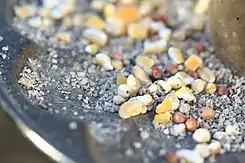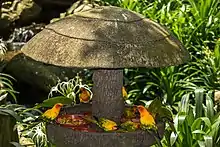Bird food
Bird food or bird seed is food (often varieties of seeds, nuts, and/or dried fruits) intended for consumption by wild and domestic birds. While most bird food is fed to commercial fowl (such as chicken or turkey), bird food is also used to feed pet birds or to provide a feeding site for wild birds.[1]

The various types of bird food reflect the variety of species of bird, which may be carnivores, herbivores, insectivores, nectarivores, etc. Bird food can also vary to correspond to the feeding strategies employed by different beak shapes in cracking the seed coat and obtaining the meat of the seed.[2]
Black-oil sunflower seeds attract the widest variety of birds,[3] and are commonly used in backyard bird feeders.[4] Using different varieties of seed can help attract specific types of birds to gardens and backyards. In general, mixtures that contain red millet, oats, and other "fillers" are not attractive to most birds and can lead to waste as the birds sort through the mix,[5] as well as the potential for fungal and bacterial growth.
While popular, bird feeders carry potential risks for the birds that feed there, including disease,[6] malnutrition,[7] and predation by animals.[8] Researchers recommend that bird feeders be disinfected every time they are refilled.[6]
Types
Natural

Seed
Black sunflower seeds are often used in bird feeders, since they attract a wide variety of birds, have a high ratio of seed material to the shell, and are high in fat content, the latter of which being nutritionally important for winter birds.[9][10] Other common bird seeds include Niger, or thistle seed, a favorite of goldfinches and redpolls. Millet is used to attract sparrows and juncos, as well as safflower for cardinals.[9][10]
Non-seed
Suet is often given to insect-eating birds like nuthatches and woodpeckers while sugar-water can attract hummingbirds.[9] However, this can lead to nutrient deficiencies and increased defecation for these birds. Although bread and kitchen scraps are often fed to ducks and gulls, this is strongly discouraged as this can cause Angel wing disease.[11][12] Chickens are commonly fed maize, wheat, barley, sorghum, and milling by-products, in a mixture traditionally called chicken scratch. Pet parrots are fed fresh fruit, vegetables, and nuts, in addition to seeds.
These seeds and non-seed supplies are commonly obtained as by-products on farms, but can also be bought from independent retailers.
Commercial

Non Farm
Commercial bird food is widely available for feeding wild and domesticated birds, in the forms of both seed combinations and pellets.[10][13]
When feeding wild birds, the Royal Society for the Protection of Birds (RSPB)[14] suggests that it be done year-round, with different mixes of nutrients being offered each season. Selections should have additional fat content in the winter months, and additional proteins in the form of nuts, seeds, and dried worms in summer, when birds are changing their plumage and may be molting.
Farm
Farmed birds that are fed with commercial bird food are typically given a pre-blended feed consisting largely of grain, protein, mineral, and vitamin supplements. Examples of commercial bird food for chickens include chick starter medicated crumbles, chick grower crumbles, egg layer mash, egg layer pellet, egg layer crumbles, egg producer pellets, and boilermaker med crumbles.[15] Pellet crumbles are often prepared for tiny chicks whereas mash is more finely ground.
See also
References
- "What do Birds Eat? | What to Feed Wild Birds". The RSPB. Retrieved 20 December 2022.
- Tryjanowski, Piotr; Møller, Anders Pape; Morelli, Federico; Indykiewicz, Piotr; Zduniak, Piotr; Myczko, Łukasz (18 May 2018). "Food preferences by birds using bird-feeders in winter: a large-scale experiment". Avian Research. 9 (1): 16. doi:10.1186/s40657-018-0111-z. ISSN 2053-7166.
- "Feeding Birds: a Quick Guide to Seed Types". All About Birds. 20 April 2009. Retrieved 20 December 2022.
- Wilson, © Sam. "Feeding Birds". FeederWatch. Retrieved 20 December 2022.
- "Feeding Birds: A Quick Guide to Seed Types". 20 April 2009. Archived from the original on 26 February 2021. Retrieved 15 March 2021.
- "Birds that eat at feeders more likely to get sick, spread disease". Archived from the original on 23 September 2015. Retrieved 31 January 2017.
- "Feeding birds". The RSPB. Archived from the original on 6 December 2021. Retrieved 31 January 2017.
- "Backyard Feeders: Dangers To Watch Out For | Petcha". www.petcha.com. Archived from the original on 3 February 2017. Retrieved 31 January 2017.
- "What to Feed Birds". Archived from the original on 10 August 2006. Retrieved 23 August 2006."Seeds and Grains for Birds". Archived from the original on 27 September 2013. Retrieved 23 August 2006.
- Porter, Diane. "Winter Bird Feeder: Keep Them Coming Back". Archived from the original on 3 September 2017. Retrieved 23 August 2006.
- "Angel Wing: Please do NOT feed bread products to waterfowl (ducks and geese)" (PDF). Green Bay, WI. Retrieved 3 March 2023.
- "Help local geese stay healthy by not feeding them". Missouri Department of Conservation. Retrieved 3 March 2023.
- "Choosing Bird Food". Cornell Lab of Ornithology. Archived from the original on 5 February 2017. Retrieved 23 August 2006.
- "When to feed wild birds". The RSPB. Archived from the original on 1 March 2016. Retrieved 2 March 2016.
- Jacob, Dr. Jacquie. "Feeding Chickens for Egg Production". Extension.org. Extension. Archived from the original on 16 January 2019. Retrieved 15 January 2019.